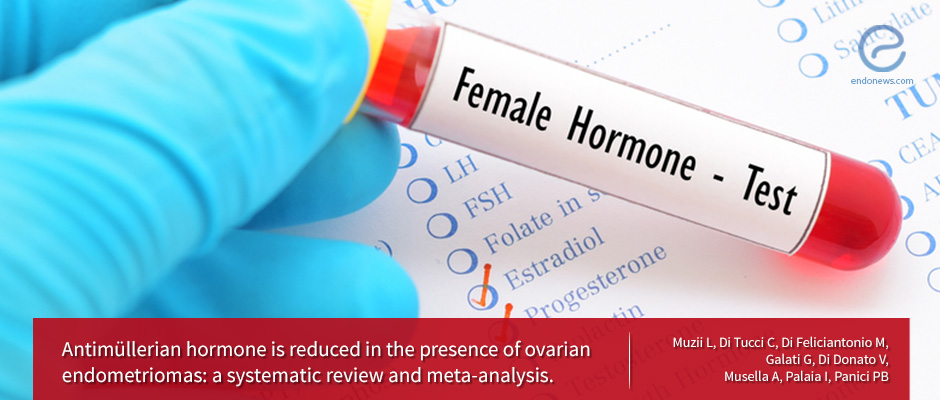Does ovarian endometrioma damage the ovarian reserve?
Nov 27, 2018
A systematic review shows that antimullerian hormone is reduced in the presence of ovarian endometrioma.
Key Points
Highlight:
- The presence of an ovarian endometrioma, and not only its surgical excision, is associated with reduced levels of serum antimullerian hormone (AMH), both when compared to non-endometriosis ovarian cysts and to healthy ovaries.
Background:
- Ovarian endometriomas are commonly present in women with endometriosis and are often associated with infertility and pelvic pain.
- Cyst excision is associated with better results in terms of postoperative pain relief, pregnancy rates, and cyst recurrence rates compared to non-excisional techniques.
- A recent meta-analysis raised a question on the safety of the excisional technique. A significant postoperative reduction of ovarian reserve as measured AMH is considered as a cyst excision-related problem.
- There is another possibility that the presence of the endometrioma may damage the ovarian reserve.
- In this paper, Dr. Panici group from Italy try to answer the question whether the presence of an ovarian endometrioma has an impact on the ovarian reserve as measured by AMH, comparing AMH levels in patients with unoperated endometriomas versus controls without endometriomas, by a meta-analysis.
Key points:
- Of the 39 studies were pre-selected after the electronic search, 17 were included, for a total of 968 patients with endometriomas and 1874 without endometriomas.
- The primary analysis was aimed at evaluation of AMH levels in patients with and without endometriomas including both non-endometriosis benign ovarian cysts and healthy ovaries. AMH was significantly lower in patients with unoperated endometriomas compared to patients with no endometriomas (P<0.00001).
- Secondary analyses were aimed at evaluating AMH levels in patients with endometrioma either versus patients with non-endometriosis benign ovarian cysts or versus patients with healthy ovaries. A significantly lower AMH level was observed in the endometrioma group compared to non-endometriosis ovarian cysts (P=0.002) and healthy ovaries (P=0.001).
Importance:
- Ovarian reserve evaluated by the AMH is reduced in patients with ovarian endometriomas, compared both to patients with other benign ovarian cysts and to patients with healthy ovaries.
Lay Summary
Ovarian endometriomas are commonly present in 17% to 44% of women with endometriosis and are often associated with infertility and pelvic pain. There are several treatment options including surgical treatment. Cyst excision is associated with better results in terms of postoperative pain relief, pregnancy rates, and cyst recurrence rates compared to non-excisional techniques.
A recent meta-analysis, however, has questioned the safety of the excisional technique, since it may be associated with a significant postoperative reduction of ovarian reserve as measured by antimullerian hormone (AMH). What is much less investigated in the literature, is the possibility that the presence of the endometrioma per se, and not only its excision, may damage the ovarian reserve.
To answer the question if the presence of an ovarian endometrioma has an impact on the ovarian reserve, Dr. Panici group from Italy systematically review and perform meta-analysis by comparing AMH levels in patients with unoperated endometriomas versus controls without endometriomas.
Thirty-nine studies were pre-selected after the electronic search based on the article title and abstract, and after the manual search of the reference list of the full articles. 17 were included, for a total of 968 patients with endometriomas and 1874 without endometriomas. The primary aim was the evaluation of AMH levels in patients with and without endometriomas including both non-endometriosis benign ovarian cysts and healthy ovaries. It was observed that AMH levels were significantly lower in the endometrioma group compared to patients with no endometrioma.
Secondary analyses aimed at evaluating AMH levels in patients with endometrioma either versus patients with non-endometriosis benign ovarian cysts or versus patients with healthy ovaries. A significantly lower AMH level was observed in the endometrioma group compared to non-endometriosis ovarian cysts. AMH levels were also significantly lower in endometrioma group compared to healthy ovaries.
In conclusion, this systematic review and meta-analysis performed by Dr. Benedetti-Panici group demonstrate that the presence of an ovarian endometrioma, and not only its surgical excision, is associated with reduced levels of serum AMH, both when compared to non-endometriosis ovarian cysts and to healthy ovaries.
Research Source: https://www.ncbi.nlm.nih.gov/pubmed/30316440
Antimullerian hormone Endometrioma Endometriosis Ovarian reserve

